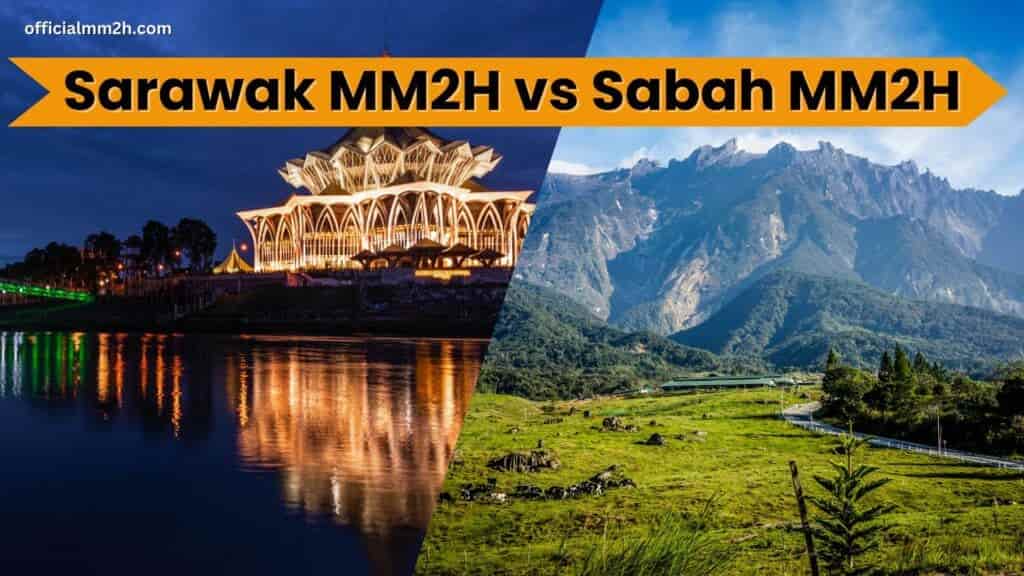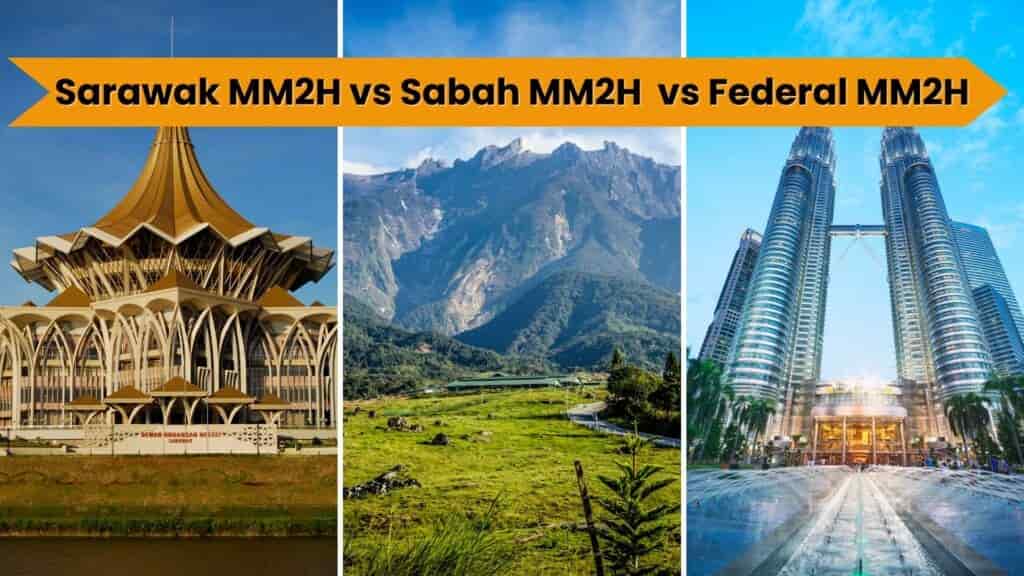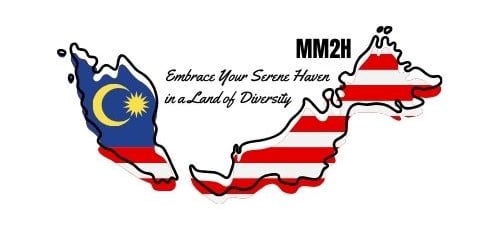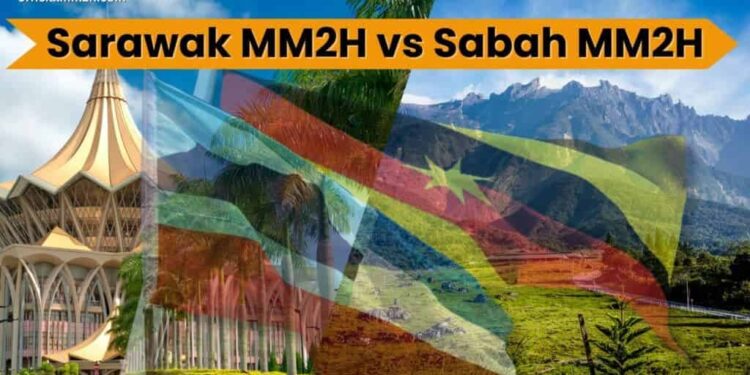Sarawak MM2H Vs Sabah MM2H: A Comprehensive Comparison
Deciding on the perfect location for a second home is no small feat, especially when navigating Malaysia’s MM2H program. Figuring out whether Sarawak or Sabah offers more value was a journey I embarked on.
After delving into all the nuances, some key differences emerged that could significantly influence your decision. Let’s dive into those distinctions together, so you can make the best choice for yourself…
Trust me, it’s an insight you won’t want to miss!
Key Takeaways
- Sarawak’s MM2H program asks for a lower deposit than Sabah. For Sarawak, individual need to put down MYR 150,000, and couple need MYR 300,000. While Sabah, Datuk Christina Liew, who is the Culture and Environment Minister of Sabah stated that a fixed deposit of MYR 200,000 in a Malaysian bank would be among the requirement. This makes it easier for many to join.
- In contrast, Sabah’s MM2H requires a bigger fixed deposit of MYR 200,000 in a Malaysian Bank as stated by Datuk Christina Liew, who is the Culture and Environment Minister of Sabah. She did not mention whether the minimum amounts would vary based on the size of the family. This is a brand new option for those dreaming of Malaysian shores, launched just this year.
- In Sabah, programme participants allowed to sell their properties after five years on condition they must buy a new house worth no less than RM600,000. While in Sarawak, an approved participant is allowed to purchase a residential house in Sarawak at a minimum price of RM600,000.00 per unit for Kuching and RM500,000.00 per unit for other divisions.
- Both programs help the local economy by bringing people who can support themselves financially into the region.
Overview of Sarawak MM2H vs Sabah MM2H Programs

So, we’re talking about two places: Sarawak and Sabah. Both offer a MM2H visa program. This means you can live in these beautiful parts of Malaysia with some conditions to meet. You need money in the bank to show you can live there without financial trouble.
It’s pretty straightforward but each place has its own rules on how much you need.
Key Eligibility Criteria
Alright, let’s kick things off by diving into the Sarawak and Sabah MM2H programs, specifically focusing on the key eligibility criteria. I’m here to lay it all out in a way that’s easy to digest. For those eyeing Malaysia as a second home through the MM2H scheme, understanding these requirements is crucial. Here goes:
| Criteria | Sarawak MM2H | Sabah MM2H |
|---|---|---|
| Fixed Deposit | MYR 150,000 (Individual) MYR 300,000 (Couple) | MYR 200,000 (Not official yet whether the minimum amounts would vary based on the size of the family) |
| Property Purchase | An approved participant is allowed to purchase a residential house in Sarawak at a minimum price of RM600,000.00 per unit for Kuching and RM500,000.00 per unit for other divisions. | At least MYR 600,000 for an apartment |
| Minimum Stay | 30 days per year | 30 days per year |
Now, let’s break it down further with some insights into what these programs mean for applicants and the local economy.
Comparing these two, it’s clear that Sarawak and Sabah offer unique advantages depending on what you’re looking for. Sarawak’s MM2H demands a lower fixed deposit for individual and lower property purchase per unit for other divisions except for Kuching. But both Sabah and Sarawak MM2H offering flexibility those who wish to explore or need to move around within the country but still wish to call Borneo home.
The impact of these programs? Well, they’re a win-win in my book. They attract folks who can contribute to the local economy while giving participants a fantastic lifestyle in a beautiful part of the world.
In wrapping this up, picking between Sarawak and Sabah’s MM2H programs boils down to personal lifestyle choices and financial capabilities. The choice is rich with possibility.
Financial Requirements

So, I’m diving right into the heart of the Malaysia My Second Home (MM2H) programs offered by Sarawak and Sabah. Trust me, this topic has layers, like an onion, and we’re peeling them away one by one. Let’s talk money – specifically, the financial requirements to join either of these programs. It’s all about showing you can support yourself without working locally, and each place has its own rules.
For those who thrive on details, here’s the lowdown in a neat table:
| Requirement | Sarawak MM2H | Sabah MM2H | Federal MM2H |
|---|---|---|---|
| Fixed Deposit | MYR 150,000 (individual) and MYR 300,000 (couple) | MYR 200,000 (Not official yet whether the minimum amounts would vary based on the size of the family) | MYR 500,000 (Silver category), MYR 2 million (Gold category) and MYR 5 million (Platinum category) |
| Minimum Property Purchase | Participants could make partial withdrawal of their Fixed Deposit (maximum 40% of the Fixed Deposit amount) from the second year onwards to purchase house at a minimum price of RM600,000.00 per unit for Kuching and RM500,000.00 per unit for other divisions. | Allowed to purchase apartments in Sabah, but they will need to spend a minimum of MYR 600,000 | Allowed to withdraw a maximum of 50 per cent of the Fixed Deposit after a year to purchase properties valued at MYR 750,000 |
Now, why does this matter? Well, it’s a big part of choosing between Sarawak’s MM2H and Sabah’s MM2H. Let’s break it down.
Sarawak’s program asks for less upfront in the deposit department compared to Sabah’s MM2H. I mean, MYR 150,000 isn’t peanuts, but it’s easier on the wallet than the MYR 200,000 Sabah and MYR 500,000 silver category for Federal. It shows they’re keen on having folks who can uphold a certain lifestyle.
Then there’s the property purchase angle. Sabah and Sarawak MM2H makes it clear—if you’re coming in, they’d like you to invest in the local housing market to the tune of at least MYR 600,000. Federal program also pressing this button, they’d like you to invest in the local housing market to the tune of at least MYR 750,000.
I find these contrasts fascinating. Each program aims to attract a certain type of applicant, impacting not only the individual’s living conditions but also the local economies. More deposits and investments mean more money flowing through these regions, supporting businesses and potentially leading to improvements in local services and infrastructure.
So, there you have it—a straightforward comparison of the financial hoops you’ll need to jump through for Sarawak’s and Sabah’s MM2H programs. It’s all about finding the right fit for your lifestyle and financial situation. No wrap-up needed; the choice is yours to ponder.
Impact on Applicants and Local Economy

The Sarawak and Sabah MM2H programs make moving here easier for folks like me, dreaming of living in such amazing places. With these programs offering softer entry rules, they’re drawing more people to the area.
This is great for us applicants because it means we can enjoy Malaysia’s beauty with less fuss. It’s also fantastic for the local economy – more people moving in means more money spent at local shops and on housing.
Sabah’s new approach to MM2H, asking newcomers like me to put down RM200,000 and maybe buy a house for over RM600,000, sounds huge. Yet, this big spend is actually good news for their real estate scene. It boosts property sales and brings in lots of cash into the community.
Living in Sabah or Sarawak isn’t just about enjoying the sights; it’s about becoming part of a place thriving thanks to new faces from around the world adding flavor to local life.
The Malaysian states’ decision-making power over immigration policies surely helps keep things smooth for people eager to call these beautiful spots home while making sure those steps boost rather than burden their economies.
Conclusion
Choosing between Sarawak MM2H and Sabah MM2H feels like picking your favorite flavor of ice cream. Both are good! Sarawak’s option is less expensive upfront, making it sweet for many.
On the other hand, Sabah asks for more money but offers its own perks. It’s cool they let people live all over Malaysia while enjoying these benefits. For me, the big win is seeing how both plans make coming to Malaysia easier on the wallet compared to other options out there.
So, whether you’re leaning towards Sarawak or Sabah, you’re in for a treat with these programs giving you a taste of life in Malaysia.





Hi Ms. Ling,
In your article “Sarawak MM2H Vs Sabah MM2H: A Comprehensive Comparison”, the property purchase requirement for Sabah should be at least MYR 600,000 for an apartment. Does this mean MM2H applicants are not permitted to purchase landed homes instead of apartments?
Any further relevant information you can provide is much appreciated.
Thank you.
Sincerely,
Tuck Lye
In the context of the MM2H program in Sabah, the property purchase requirement indeed specifies a minimum value of MYR 600,000, but this pertains primarily to apartments. However, it’s important to note that this does not exclude the possibility of purchasing landed properties. The requirement is primarily about the minimum investment threshold for property under the MM2H program, which can include various types of real estate, such as apartments or landed homes, as long as they meet the stipulated minimum value.
Hi Ms Ling,
With regards to the 30days min stay for both (Sarawak & Sabah), this 30 days means in Sarawak & sabah itself right? Or this 30days can be clock in West Malaysia even if you took up the sabah/sarawak MM2H program?
Thanks to confirm.
Best Regards
The 30 days minimum stay requirement for both the Sarawak and Sabah MM2H programs specifically refers to staying within Sarawak or Sabah. This means that for you to meet the requirement, you need to spend at least 30 days in either Sarawak or Sabah itself, not in West Malaysia. This is part of the conditions to ensure that participants engage with the local community and lifestyle in these regions.
Hi Ava :
I am considering semi-retiring in East Malaysia. A Canadian citizen having live in Canada for more than 30 years but originally from Singapore. My family & I are a mixture of the 3 main races ie. Malay / Chinese & Indian & still speak the local languages. Not talking financial in terms of life-styles for: (1) food ( 2) safety (3) environment (4 ) people-friendliness (5) outdoor activities (6) health & dental services – then how would you rate these 3 cities : ( 1) Kuching (2) Miri (3) Kota Kinabalu.
Appreciate to receive your reliable feedback
That sounds like an exciting consideration! Here’s a brief comparison based on the factors you mentioned:
1. Food: All three cities have a diverse range of food options, reflecting the multiculturalism of Malaysia. Kuching is particularly known for its unique Sarawakian dishes, while Kota Kinabalu offers a mix of local and seafood delicacies. Miri has its own delicious offerings, primarily influenced by the various cultures in the area.
2. Safety: Generally, all three cities are considered safe, with low crime rates compared to other regions. Kuching is often noted for its friendly atmosphere, while Kota Kinabalu is bustling with tourism, which tends to promote overall safety.
3. Environment: Kuching is renowned for its green spaces and proximity to nature, making it a great choice for those who love the outdoors. Miri, being close to national parks and beaches, also offers a beautiful environment. Kota Kinabalu has stunning coastal views and is near the iconic Mount Kinabalu.
4. People-friendliness: All three cities are known for their hospitality and friendly locals. Kuching, with its rich cultural heritage, feels very welcoming, while Miri and Kota Kinabalu also boast warm communities.
5. Outdoor activities: Kuching offers various outdoor activities, including visiting national parks and cultural experiences. Miri is great for diving and exploring nature. Kota Kinabalu is perfect for mountain climbing, snorkeling, and enjoying beaches.
6. Health & dental services: Kota Kinabalu generally has the most extensive healthcare facilities among the three, including private hospitals. Kuching also has good healthcare services, while Miri, being smaller, may have fewer options, but still provides essential services.
Overall, each city has its unique charm and advantages, so it really depends on your personal preferences! If you enjoy a quieter, more culturally rich environment, Kuching might be ideal. For a mixture of urban and outdoor lifestyle, Kota Kinabalu could be the best fit. Miri is perfect if you appreciate a smaller town vibe with access to natural beauty. I hope this helps!
I’m planning to move from Australia next year and I would be 35 by then. I have got a small software business that I want to register in Sabah or Sarawak. Also I would fly to Perth every month for a week.
I’m not sure which state offers better business benefits or easier to run business or sponsor some employees.
Which state would be easier for the flights to Perth.
And which state would be better for kids schooling.
Thanks
Az
I’m happy to help with your plans to move your business from Australia to either Sabah or Sarawak. Here’s some tailored advice:
Business Benefits: Sarawak has been focusing on digital economy initiatives, which might align well with your software business. Sabah, on the other hand, is increasing its infrastructure investment, potentially providing good opportunities for business growth. Both states have incentives for foreign investment, but you may find Sarawak’s specific focus on digital industries more beneficial .
Ease of Running a Business and Sponsoring Employees: Both states facilitate business operations through investment authorities, but the process can vary. It’s crucial to look into specific requirements for registering a business and sponsoring employees in each state via online resources or local business consultants.
Flights to Perth: Kota Kinabalu International Airport in Sabah might offer slightly better connectivity options with more frequent flights to Kuala Lumpur, the primary transit hub for international flights, including those to Perth. It’s worth checking the latest flight schedules to confirm this.
Schooling for Kids: Both Sabah and Sarawak offer good schooling options. Sabah might have a slight edge in terms of international schools due to its larger expatriate population. However, Sarawak also hosts reputable schools that are suitable for expatriate families .
It’s a good idea to visit both states, if possible, to get a feel for what each offers in terms of lifestyle and community. Best wishes with your move!